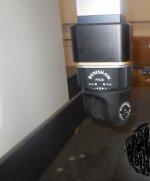Good Morning, Larry --
There isn't a general answer to your question(s); we need a full description of the (a = 0, b = 0) condition, if the object being rotated is a single-axis or a three-axis system, which A-or-B axis remains parallel to which X-or-Y-or-Z axis no matter how the other B-or-A axis is rotated.
And, unfortunately, I am swamped enough over the next few days that I probably won't be able to devote any significant time until next week.
I'll offer a few generalities, that may help you figure out your own answer:
The Direction (a mathematical construct that is often defined as "a Vector of undefined Radius", which is a pretty-poor definition since a Vector is defined as having "a Direction and Radius".
Vectors are quantified most often as a Cartesian Triple, with the Origin of the Vector at the Origin of the Cartesian Reference Frame, and the End Point of the Vector at the specified (x, y, z) location. The Magnitude of such a Vector is the straight-line distance between , the Origin and End Point which can be calculated as the Square Root of (x^2 + y^2 + z^2).
If the Magnitude of the Vector is exactly 1, the (x, y, z) triple is exactly equal to the (i, j, k) triple.
Directions can also be quantified as a Spherical Pair (a, b) where a = Rotation around A and b = Rotation around B. Since a and b are rotation angles, finding the equivalent Cartesian Triple (x, y, z) requires a bit of trigonometry. So let's assume that the (a = 0, b = 0) position is with A exactly parallel to X, and B exactly parallel to Y. Let us also assume that there is a C axis that is exactly parallel to Z . . . which means C is exactly perpendicular to A, B, X, and Y.
If we rotate the A, B, C system around A by some amount a, A does not change position with respect to the X, Y, Z Coordinate Frame, but B and C both move in the Y, Z Plane, "becoming" B' and C', which effectively creates a new Coordinate Reference Frame A' B' C'.
Subsequent rotation about B' rotates A' and C' in the plane that they define, creating another new Coordinate Reference Frame A", B", C".
If, as I suspect, you are asking how to determine the (i, j, k) values of C", and the geometry of the starting position is as I speculated . . . I THINK that the simple algorithms are these:
i of C" = Sine b
j of C" = -1 x Sine a x Cosine b
k of C" = Cosine a x Cosine b
By way of warning, I haven't done this type of arithmetic in a few years, and I'm pretty well oxidized. I strongly urge you to draw your own cartoons, and try to understand the geometry of the situation.
Finally, by way of a tip: When you draw your cartoons, set the A-or-B rotational axis that DOESN'T change position relative to the X,Y,Z Cartesian frame perpendicular to the paper.
Lunch hour's over, gotta run. Hope this helps.
John


